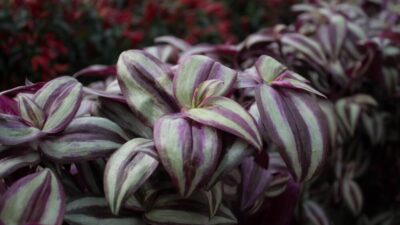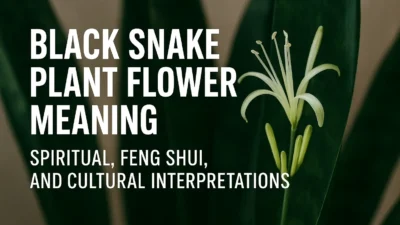Mastering wandering jew plant care is essential for anyone looking to cultivate its strikingly vibrant, purple and silver foliage.
The Wandering Jew plant, a name encompassing several Tradescantia species, remains a cherished staple in the world of houseplants. Its charm comes from the stunning contrast between the deep purple undersides and the bright, silvery-green stripes on its leaves.
This fast-growing vining plant gives great rewards for simple care. Perfect for hanging baskets and shelves. Its trailing tendrils can cascade down beautifully.
Achieving a lush, vibrant specimen hinges on understanding a few fundamental aspects of its care. Before delving into care, it’s helpful to know the plant itself.
The common name “Wandering Jew” primarily refers to three species:
- Tradescantia zebrina (recognizable by its silver tripes)
- Tradescantia fluminensis (often solid green or with white variegation), and
- Tradescantia pallida (known for its solid, deep purple foliage).
All share similar growth habits and care requirements, thriving in conditions that mimic their native tropical understory habitats.
Table of Contents

Essential Wandering Jew Plant Care Guidelines
Providing the correct environment is the most critical factor in care for a wandering jew plant. When you meet its basic needs for light, water, and soil, it rewards you with vigorous, colorful growth.
Ideal Lighting Conditions
This plant demands bright, indirect light to maintain its stunning leaf coloration and prevent legginess.
- A spot near an east or west-facing window is often perfect, providing several hours of gentle sunlight.
- While it can tolerate some direct morning sun, intense afternoon rays can scorch the delicate leaves, causing brown, crispy tips.
- In low light, the bright purple and silver markings will turn dull green. The spaces between leaves will stretch, making the plant look sparse.
Watering Requirements and Humidity Preferences
Consistent moisture is key, but overwatering is a common misstep. The goal is damp soil, not a soggy environment.
- Water thoroughly when the top inch of soil feels dry to the touch. Allow excess water to drain completely from the pot’s bottom, never letting the plant sit in a saucer of water.
- Reduce watering frequency during the fall and winter months when plant growth naturally slows down.
- As a tropical plant, it appreciates higher humidity levels. Brown leaf tips can signal air that is too dry. You can boost humidity by putting the plant on a pebble tray with water. You can also group it with other plants or use a room humidifier.

Optimal Soil and Fertilization Routine
The right soil mixture supports healthy roots and prevents waterlogging.
- A well-draining, peat-based potting mix is ideal. Many gardeners choose to amend a standard potting mix with perlite or orchid bark to enhance drainage further.
- Feed the plant with a balanced, water-soluble fertilizer. Dilute it to half-strength. Do this every four weeks in spring and summer.
- Stop fertilizing in the autumn and winter. The plant is not growing during this time and won’t use the nutrients.
Temperature and Environmental Factors
Wandering Jew plants prefer the same comfortable temperatures that humans do.
- Average household temperatures between 60°F and 80°F (15°C – 27°C) are perfect.
- Protecting the plant from cold drafts, sudden temperature drops, and frost is crucial, as these factors can cause significant damage. Avoid placing it near leaky windows or air conditioning vents.
Maintenance and Propagation For Wandering Jew Plant Care
Beyond the basics, a little maintenance goes a long way in keeping the plant dense and attractive.
Pruning and Pinching
Regular pruning is not just beneficial; it is essential for a full, bushy plant.
- Pinch or trim off the tips of the vines regularly to encourage branching from lower nodes. This prevents the plant from becoming long and stringy.
- Use clean, sharp scissors to remove any dead, yellowing, or damaged leaves and stems. This not only improves appearance but also improves air circulation.
Easy Propagation Techniques
Propagating a Wandering Jew is remarkably simple, allowing you to create new plants or refresh an old, leggy one.
- The most effective method is stem cuttings. Snip a 3 to 6-inch piece of a healthy vine, just below a leaf node.
- Remove the leaves from the bottom few nodes and place the cutting in a glass of water. Roots will typically emerge within a week.
- Once the roots are an inch or two long, pot the cutting in fresh soil. Alternatively, you can plant cuttings directly into moist soil, and they will root quickly.
You May Also Like: How To Acclimate Tissue Culture Plant ? Mastering Guide

Repotting Practices
Because of its rapid growth, the plant may require repotting every year or two.
- Repot in the spring, at the start of the growing season.
- Choose a new pot that is only one size larger than the current one. A pot that is too large will hold excess moisture around the roots.
- Gently loosen the root ball and place it in the new container with fresh potting mix.
Troubleshooting Common Issues in Care of Wandering Jew Plant
Even with the best care, issues can occasionally arise. Prompt identification is the first step to a solution.
Pest Management
Aphids and Spider Mites
These small sap-sucking insects are the most common pests. Look for signs like stippled leaves, fine webbing (for mites), or sticky residue.
Treat infestations immediately by rinsing the plant with a strong stream of water in a shower or sink. For persistent problems, apply insecticidal soap or neem oil, ensuring to coat the undersides of leaves.
Addressing Leaf Problems
- Brown, Crispy Leaf Tips: This is often caused by low humidity, not enough water, or salt buildup from tap water. Switch to distilled or filtered water and increase humidity.
- Yellowing, Limp Leaves: A classic sign of overwatering and potential root rot. Allow the soil to dry out more between waterings and ensure the pot has adequate drainage.
- Faded Leaf Color: Insufficient light is the most common cause. Move the plant to a brighter location.
You May Also Like: Heavenly Bamboo Plant: Comprehensive Growing Guide, Toxicity Insights, and Responsible Cultivation
Frequently Asked Questions About Wandering Jew Plant Care
Is the Wandering Jew plant toxic to pets?
Yes, the plant is considered mildly toxic to cats and dogs. Ingestion can cause irritation of the mouth and stomach, potentially leading to drooling, vomiting, or diarrhea. It is advisable to keep the plant in a location inaccessible to curious pets.
Why is my plant becoming leggy and sparse?
Legginess is almost always caused by insufficient light. The plant stretches toward the nearest light source. To remedy this, move it to a brighter spot and prune the long stems back to a leaf node to encourage bushier growth from the base.
How often should I water my Wandering Jew precisely?
There is no universal schedule. The frequency depends on factors like pot size, light levels, and room temperature. The “top inch” rule is the most reliable guide: water only when the top inch of soil is dry.
What should I do if the base of the plant looks bare?
It is natural for older stems to lose some leaves at the base over time. The best solution is to take stem cuttings from the healthy ends of the vines and propagate them. Plant these new cuttings back into the same pot to fill out the base and create a denser, more youthful plant.



